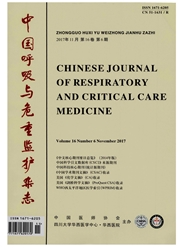

 中文摘要:
中文摘要:
目的 比较气管内滴入脂多糖与腹膜腔注射脂多糖两种不同方法复制的急性肺损伤小鼠模型的生理、病理特点及动态变化。方法 BALB/c小鼠麻醉后分别经气管内滴入脂多糖(5 mg/kg)和经腹膜腔内注射脂多糖(5 mg/kg)。在脂多糖处理后第1、2、6、12、18、24、48 h处死小鼠,通过检测支气管肺泡灌洗液(BALF)蛋白含量、肺湿/干重比值和肺组织病理半定量评分评价呼吸系统损伤程度,ELISA法检测血清与BALF上清中肿瘤坏死因子-α(TNF-α)浓度以了解全身与肺局部炎症反应程度。结果 两组脂多糖处理小鼠的BALF中蛋白含量、肺湿/干重比值、血清/BALF中TNF-α浓度均增高。腹膜腔注射脂多糖小鼠肺湿/干重比值较气管滴入脂多糖小鼠高,其余上述指标在两组间无显著差异。两组小鼠在脂多糖处理后肺组织炎症细胞浸润、肺泡间隔增宽、肺组织病理半定量评分均明显增高,以气管内滴入组病理损伤较显著。结论 气管内滴入脂多糖与腹腔注射脂多糖均可引起肺局部炎症与组织损伤,两种模型病理损伤程度差异较大,自身好转趋势不同,应根据实验目的选择合适的模型复制方法。
 英文摘要:
英文摘要:
ObjectiveTo compare two different ways to establish mouse model with acute lung injury (ALI) via intratracheal instillation or intraperitoneal injection of lipopolysaccharide (LPS). MethodsBALB/c mice received intraperitoneal/intratracheal administration of LPS or sham operation. Wet/dry lung weight ratio, protein concentration in bronchoalveolar lavage fluid (BALF), and lung tissue histology were examined at 0, 1, 2, 6, 12, 18, 24, 48 h after LPS administration. Tumor necrosis factor-α (TNF-α) in BALF and serum was assayed with ELISA method. ResultsLPS treatment significantly increased wet/dry lung weight ratio, BALF protein concentration and TNF-α concentration in serum and BALF. Lung tissue was damaged after LPS challenge. The mice received LPS intraperitoneal injection got a more significant lung edema than those received LPS intratracheal instillation. Inversely, LPS intratracheal instillation induced more severed microstructure destruction. ConclusionsALI animal model by LPS intratracheal instillation or intraperitoneal injection induces inflammation and tissue damage in lung. However, the degree of tissue damage or self-healing induced by two methods is different. Therefore the decision of which way to establish ALI model will depend on the study purpose.
 同期刊论文项目
同期刊论文项目
 同项目期刊论文
同项目期刊论文
 期刊信息
期刊信息
